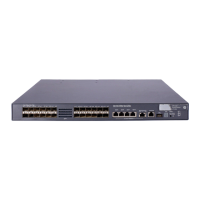188
[DeviceC-GigabitEthernet1/0/3] port service-loopback group 1
# In tunnel interface view, configure the tunnel to reference service loopback group 1.
[DeviceC-GigabitEthernet1/0/3] quit
[DeviceC] interface tunnel 0
[DeviceC-Tunnel0] service-loopback-group 1
[DeviceC-Tunnel0] quit
# Enable the OSPF protocol.
[DeviceC] ospf 1
[DeviceC-ospf-1] area 0
[DeviceC-ospf-1-area-0.0.0.0] network 30.1.1.0 0.0.0.255
[DeviceC-ospf-1-area-0.0.0.0] network 40.1.1.0 0.0.0.255
[DeviceC-ospf-1-area-0.0.0.0] network 50.1.1.0 0.0.0.255
[DeviceC-ospf-1-area-0.0.0.0] quit
[DeviceC-ospf-1] quit
# Create local mirroring group 1.
[DeviceC] mirroring-group 1 local
# Configure GigabitEthernet 1/0/1 as a mirroring port and GigabitEthernet 1/0/2 as the monitor port
of local mirroring group 1, and disable STP on GigabitEthernet 1/0/2.
[DeviceC] mirroring-group 1 mirroring-port gigabitethernet 1/0/1 inbound
[DeviceC] mirroring-group 1 monitor-port gigabitethernet 1/0/2
[DeviceC] interface gigabitethernet 1/0/2
[DeviceC-GigabitEthernet1/0/2] undo stp enable
5. Verify the configurations
After the configurations are completed, you can monitor all packets received and sent by the marketing
department on the server.

